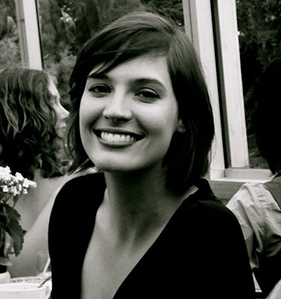
Andrea van Noord
Andrea van Noord gave her students a small taste of her job of an indexer, and in return, they offered a thoughtful new perspective on the Visual History Archive.
van Noord began indexing for USC Shoah Foundation’s Preserving the Legacy initiative in March 2015. She joined other new indexers for a month-long training session to learn how to use the Institute’s indexing software to index its new Holocaust survivor testimonies from collections in Canada and the United States. Following the training, van Noord is indexing testimonies from home in Victoria, Canada.
A scholar in narrative, trauma studies, historiography and the Holocaust, van Noord currently teaches a course called “After-Images of the Holocaust in Text and Film” at the University of Victoria. This course examines the Holocaust and its impact on subsequent generations through narrative and representation as employed by Holocaust survivors, second- and third-generation Jewish writers, filmmakers, visual artists, as well as work by individuals with no ancestral or experiential relationship to the Holocaust.
van Noord suggested that her students think of the course as an extended thought-experiment: that there is no longer living memory of the Holocaust, and all we have left are the “after-images.”
“I have always been fascinated by the ways in which we construct and communicate knowledge in the absence of shared experiences,” van Noord said. “Drawing on my work as a Holocaust testimony indexer for the USC Shoah Foundation, I am particularly interested in the “crisis of inheritance” and the evolving roles of testimony and artifact in Holocaust Education.”
On the first day of class, van Noord introduced her students to the Visual History Archive, the indexing software and methodology, and her own experiences as an indexer. They watched 20 minutes of testimony and attempted to index it together as a group, and then she instructed them to search the archive for a particular keyword and reflect upon the extent to which they felt the keyword was represented in the segments they watched. They discussed their impressions and provided the feedback to Visual History Archive Curator Crispin Brooks.
The class found the Visual History Archive “disarming” in a few unexpected ways. They were a bit unnerved to watch testimony with no music or editing like they are used to seeing in movies, which left them feeling “a bit lost emotionally, not knowing what to feel or when to feel it,” van Noord said. This led to a discussion about the effect on their generation of growing up in a media-saturated and emotionally curated world.
“In doing so the students “woke up” to the extent to which their emotions are or have been guided when confronted with main stream ‘after-images’ of the Holocaust, and how this has perhaps made it difficult to take ownership over that emotional experience, and by extension made it difficult to have an individual, active response to the Holocaust as well as other genocides and examples of human rights violations,” van Noord said.
They also wanted to know more about the indexers themselves and wished they could find out why indexers had made certain choices. Interestingly, they felt that the testimonies should be re-indexed by each generation, so that the Visual History Archive could become a repository for society’s evolving interests and thresholds, particularly regarding traditionally taboo topics like sexual assault, cannibalism and the nature of survival that may be studied more openly over time.
By introducing the Visual History Archive to her students critically, as it had been introduced to her during the indexer training, van Noord felt that they were forced to confront the nature, politics, and practical aspects of knowledge production. This analysis allowed them to make a real connection to the Visual History Archive and understand it on a deeper level.
“The main goal of the course, from my point of view, is that the students be able to think critically about the production and curation of knowledge, and I found that the Visual History Archive functions as a truly fascinating and challenging case study in this regard,” van Noord said.